Charts of the Week
Charts of the week from 27 February to 3 March 2023: consumer prices, natural gas consumption, electricity consumption and other charts
Year-on-year, consumer prices grew by 9.3% in February, which is the lowest growth in nine months. The slower growth was largely due to a further slowdown in energy price inflation, while food price inflation also slowed somewhat but is still quite high; service price inflation also remains relatively high. Amid low temperatures in the first half of the month, gas consumption in February was only about 8% lower than the comparable consumption in previous years and electricity consumption was 7% lower year-on-year. Turnover in retail trade decreased slightly in December. In 2022 as a whole, turnover was higher year-on-year in wholesale trade and retail sale of non-food products, while it was lower in the sale of food and motor vehicles. Turnover in market services also declined at the end of the year, while it was a good tenth higher in 2022 as a whole. It lagged behind the pre-epidemic levels only in administrative and support service activities, most significantly in travel and employment agencies. According to the survey data for the last quarter of 2022, unemployment fell noticeably year-on-year, while the number of people in employment remained at a similarly high level as a year ago.
Consumer prices, February 2023
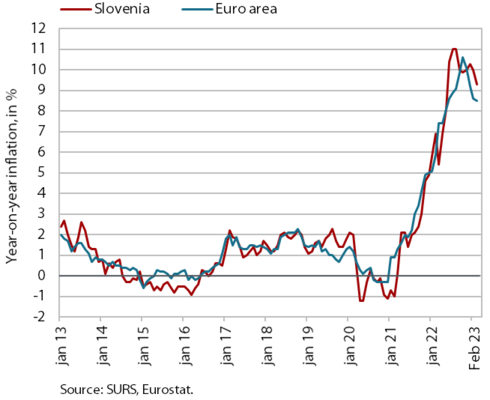
Year-on-year, consumer prices grew by 9.3% in February, which is the lowest growth in nine months. The slower growth was largely due to a lower contribution from the group housing, water, electricity, gas and other fuels, which we estimate to be mainly related to a further slowdown in energy price inflation. Growth in food prices also slowed slightly, but was still quite high at 18.3% and contributed the most to inflation (2.8 p.p.). The easing of supply chain bottlenecks and the stable situation in commodity markets also contribute to a further gradual slowdown in the increase in durable goods prices (7.7%), while the rise in semi-durable goods prices remains relatively subdued (3.7%). At just under 8%, service price inflation remains roughly unchanged, supported mainly by accommodation and food service activities and services related to recreation and culture.
Natural gas consumption, February 2023
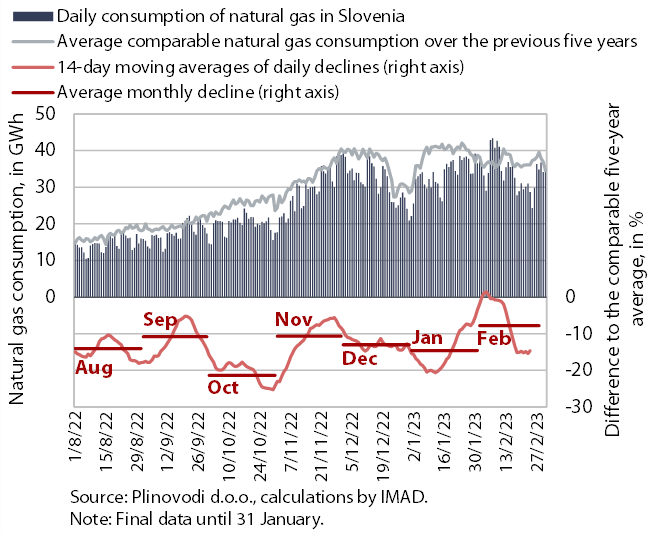
Amid low temperatures in the first half of the month, gas consumption in February was only about 8% lower than in previous years. While lower consumption can be attributed to limited production in some industries due to high gas prices and government measures to encourage more rational consumption, the weather also has a significant impact on the amount of gas consumed during the heating season. According to Eurostat, Slovenia reduced its gas consumption by 14% between August 2022 and January 2023 compared to the average consumption in the same period over the previous five years, while the average reduction by EU Member States was 19%. Lower consumption and relatively high level of gas in storage capacities in the EU currently ensure uninterrupted gas supplies.
Electricity consumption, February 2023
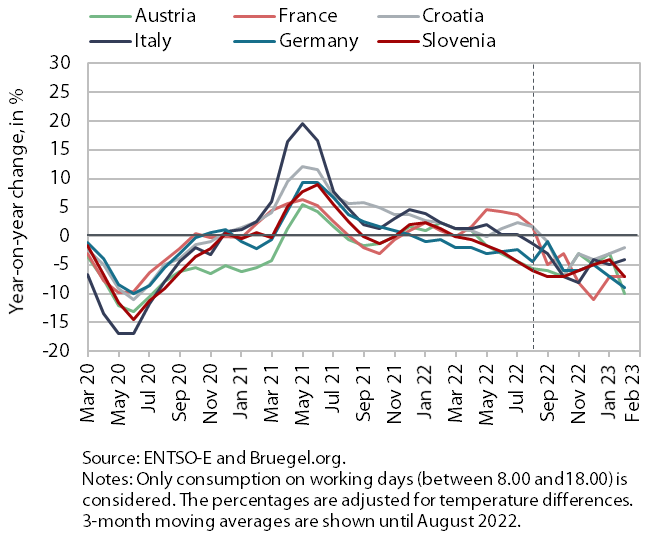
Electricity consumption was 7% lower year-on-year in February. We estimate that both industrial and household consumption were lower. Industrial consumption was, in our estimation, lower year-on-year mainly due to lower consumption by energy-intensive industries, related to high electricity prices and the resulting lower production volumes, and modernisation of production technologies to increase energy efficiency. The year-on-year decline in household consumption was, in our estimation, mainly due to the high base of last year, when more people stayed at home due to the high number of COVID-19 infections and containment measures. Slovenia’s main trading partners also recorded a decline in consumption compared to February 2022 (Austria and Germany by 10%, France by 7%, Italy by 4% and Croatia by 2%).
Turnover in trade, December 2022–January 2023
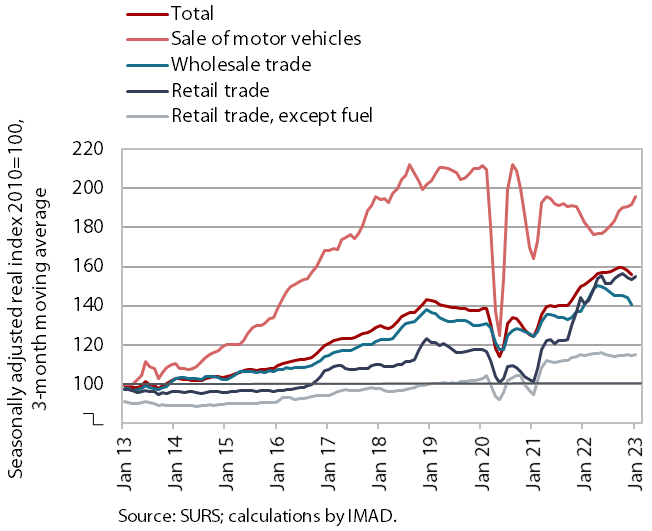
Turnover continued to fall in most trade sectors in December, before increasing slightly in January, according to preliminary data. In December, turnover in wholesale trade continued to decline amid lower activity in trade-related sectors and was also lower year-on-year in real terms for the first time in 2022; it was up 7.7% year-on-year in real terms in 2022 as a whole. Turnover in retail sale of food, beverages and tobacco also fell significantly in December, down 1.9% year-on-year in real terms in 2022 as a whole. Turnover in the sale of motor vehicles also slowed year-on-year in real terms in 2022 (by 4.8%), but turnover rose in current terms in the second half of the year as supply chain bottlenecks eased. Turnover in retail sale of non-food products, which stagnated in the second half of the year, increased by 6.1% year-on-year in real terms in 2022. According to preliminary SURS data, turnover in January compared to December was slightly stronger in retail sale of food and non-food products and significantly stronger in the sale of motor vehicles.
Turnover in market services, December 2022
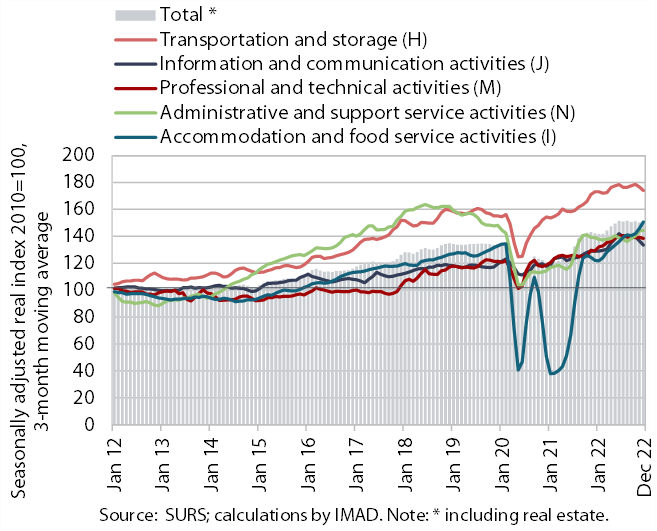
Real turnover declined further in most market services in the last quarter of 2022. After growth in the first half of the year, total turnover in market services began to decline. The decline in turnover intensified, falling by 1.1% in current terms in the fourth quarter. Turnover in transportation and storage further declined, especially in storage. The decline also intensified in information and communication activities, mainly due to lower turnover in computer services on the domestic market. Turnover in professional and technical activities also further declined slightly. In accommodation and food service activities, however, turnover increased further in the fourth quarter as the number of overnight stays increased. Turnover in administrative and support service activities increased again, with continued strong growth in travel agencies. In the last quarter of 2022, total turnover increased by 3.2% year-on-year in real terms and by 11.1% in 2022 as a whole. In market services, only turnover in administrative and support service activities remained below pre-epidemic levels (Q4 2019) (most significantly in travel agencies – by 15% and in employment agencies – by 13%).
Active and inactive population, Q4 2022
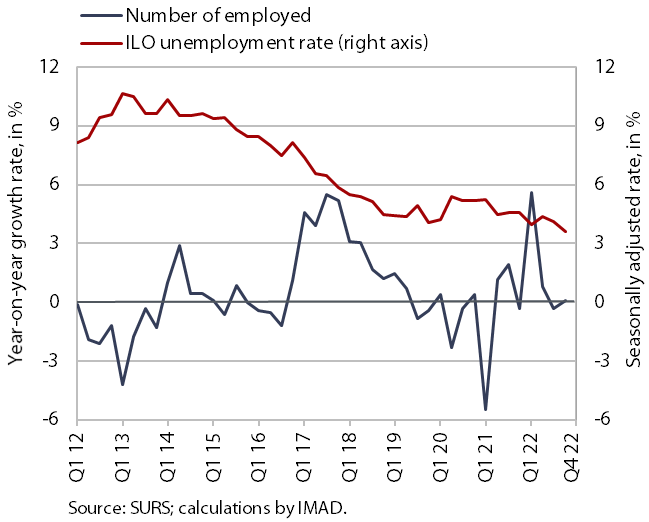
According to the survey data, unemployment fell noticeably year-on-year in the fourth quarter of last year, while the number of people in employment was largely unchanged. According to original data, 35 thousand persons were unemployed, which is 25.5% less than at the end of 2021. The survey unemployment rate (3.5%) fell by 1 p.p. year-on-year. In our view, the decline in the number of unemployed mainly reflects people’s transition into inactivity, which is normal in times of economic slowdown. Having already been high, the number of persons in employment in Q4 remained at a similar level as a year ago.
